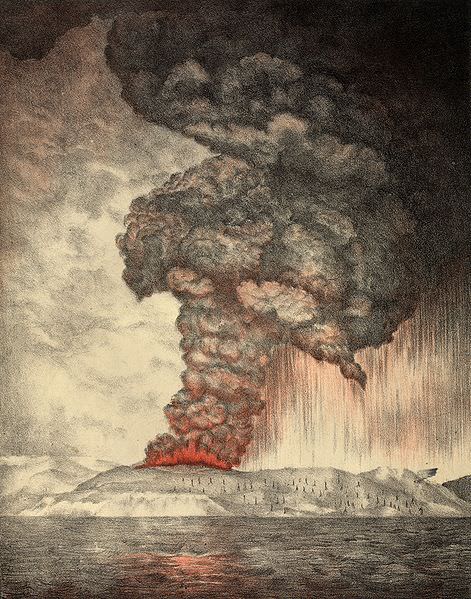[/caption]Mount Krakatoa is a volcanic island found in Indonesia. Its most famous eruption in 1883 is one of the biggest in recorded history. You guessed it right; Krakatoa belongs to the Pacific Ring of Fire, the volatile horseshoe-shaped area bordering the Pacific Ocean.
Better known as Krakatau in Indonesia, its eruption in 1883 produced a series of tsunamis that smashed into 165 coastal villages in Java and Sumatra. 36,000 people perished when those giant waves hit. Most of those who were killed during the 1883 eruption, which lasted for two days (Aug 26 to 27), were actually victims of the tsunamis.
Some of the giant waves from that eruption, which rose up to 40 meters, managed to reach the southern part of the Arabian Peninsula, some 7,000 km away. When the 2004 Indian Ocean Tsunami (a.k.a. the 2004 Indonesian Tsunami) struck, it reminded the scientific community of the 1883 eruption because of the proximity of their points of origin.
The eruption also had a large impact on the global climate. On the average, temperature dropped by as much as 1.2ºC in the succeeding year. In the years that followed, global climates were very erratic, stabilizing only 4 years after.
Mount Krakatoa’s lava was known to be made of dacite or rhyolite. This explains the magnitude of its eruption. Generally speaking, volcanic eruptions are more explosive if their lava is composed of dacite or rhyolite. They are cooler and stickier than basalt, allowing them to accumulate pressure before being set free.
Although the 1883 eruption destroyed more than 60% of the volcanic island, a submarine eruption in 1927 produced a new island in its stead. This volcano is aptly called Anak Krakatau, which is Indonesian for “Child of Krakatoa”. Anak Krakatau’s radius is estimated to be 2 kilometers and rises up to a maximum height of 300 meters above sea level. Studies have shown in to be growing at a rate of 5 meters per year.
Before 1883, three volcanoes known as Rakata, Danan, and Perbuwatan combined to what then became Krakatoa island.
Mount Krakatoa is an example of a stratovolcano, a tall, conical volcano with multiple strata of solidified lava, tephra, as well as volcanic ash. These type of volcanoes typically have steep sides and usually erupt frequently & violently. Most of the popular eruptions have been made by stratovolcanoes. Other known stratovolcanoes are Mount St. Helens and Mount Pinatubo.
Indonesia is the country that holds the biggest number of active volcanoes, at 130. Iceland, another volcano-dotted country, holds about the same number (of volcanoes) but not all are as active as those in Indonesia.
We have some articles in Universe Today that are related to Mount Krakatoa. Here are two of them:
Mount Krakatoa articles brought to you by USGS. Here are the links:
Tired eyes? Let your ears help you learn for a change. Here are some episodes from Astronomy Cast that just might suit your taste:
Sources:
http://vulcan.wr.usgs.gov/Volcanoes/Indonesia/description_krakatau_1883_eruption.html
http://hvo.wr.usgs.gov/volcanowatch/2003/03_05_22.html

